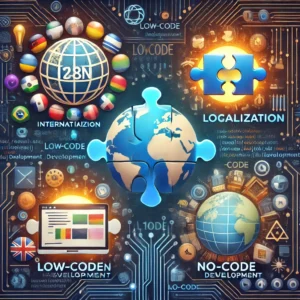1. Software Localization and Internationalization
Internationalization (i18n)
Internationalization (often shortened to i18n) refers to the process of designing and building software so that it can be easily adapted to different languages, regions, and cultures without needing to redesign the whole system.
- Think of it as preparation: Before software can be localized into different languages or regions, it needs to be internationalized first.
- It involves things like:
- Allowing text to expand or shrink depending on the language.
- Making sure the software can handle different currencies, dates, and number formats.
- Creating an architecture that can easily add new languages or regional features.

Example:
- An app that supports different languages like English, French, and Spanish, and can display dates in formats like “MM/DD/YYYY” for the U.S. and “DD/MM/YYYY” for the UK.
- Internationalization ensures the app works in all these cases before it’s translated.
Localization (l10n)
Localization (often shortened to l10n) is the actual process of adapting the software for a specific language, region, or culture. This includes:
- Translating text into the local language.
- Adapting images or design elements to suit cultural preferences.
- Changing content like phone numbers, addresses, or units of measurement to match local standards.
Example:
- Translating the text from English to French for a French market.
- Adapting images and colors to fit the cultural preferences of a specific region (for example, changing symbols or colors that might have different meanings in different cultures).
How They Work Together:
- Internationalization prepares your software to be flexible and adaptable for different languages and regions.
- Localization takes the internationalized software and customizes it for each specific market (like translating and adjusting it for French-speaking users).
In short:
- Internationalization (i18n) is the “building block” phase, ensuring your software can easily support multiple languages.
- Localization (l10n) is the “customization” phase, where you adapt the software for a specific region or language.
2. Low-Code and No-Code Development
Low-Code Development
Low-Code Development refers to the practice of using platforms that allow developers to create software applications with minimal hand-coding. These platforms provide a graphical interface and drag-and-drop components, enabling faster development with less manual coding.
- You still need some coding knowledge: Developers can write code where necessary, but the platform handles the more repetitive and technical parts.
- Faster development: It accelerates the creation of apps because you don’t have to build everything from scratch.
Example:
- A business user might use a low-code platform to create a simple workflow automation system, but a developer can still add custom functionality when needed.
No-Code Development
No-Code Development takes this idea even further. It allows users to build applications without writing any code at all. No-code platforms are designed to be so intuitive that people who have little to no programming experience can create applications.
- Completely code-free: Users can design apps using a visual interface, dragging and dropping elements to create workflows, forms, and databases.
- Great for non-developers: Ideal for business professionals, designers, or anyone who needs to build applications quickly but doesn’t have coding skills.
Example:
- A business manager might use a no-code tool to create a customer feedback form or an internal dashboard without writing a single line of code.
Key Differences:
| Feature | Low-Code Development | No-Code Development |
|---|---|---|
| Coding Knowledge | Some coding is needed (for advanced features) | No coding knowledge required |
| Customization | High customization with code added | Limited customization; relies on pre-made templates and blocks |
| Target Users | Developers and business professionals | Non-developers (business users, designers) |
| Use Case | Complex apps with more flexibility | Simple, quick apps (e.g., forms, dashboards) |
Why Are These Important?
- Low-Code and No-Code Development are transforming how software is created by making it easier and faster for people to build applications, even if they aren’t professional developers.
- These platforms allow non-technical users (like business people, marketers, or designers) to create solutions, saving time and resources while also giving more people the ability to innovate.
In Summary
- Internationalization (i18n) makes sure the software can easily support multiple languages, regions, and cultures.
- Localization (l10n) customizes the software for specific languages, countries, or cultures.
- Low-Code Development allows developers to create apps quickly using minimal coding, but still requires some technical knowledge.
- No-Code Development is for people who want to create apps without writing any code at all, using a simple drag-and-drop interface.
These concepts all make the process of developing, localizing, and customizing software faster, more efficient, and accessible to a wider range of users.
Tags: adaptable software, adapting for French market, adapting units of measurement, app translation, cultural customization, cultural symbols in software, currency support, date format handling, global software deployment, global software design, global user experience, i18n, international software standards., international-ready software, internationalization, internationalization vs localization, l10n, language packs, language support, language translation, language-neutral coding, localization, localization examples, localized UI, localized UX, multilingual app, multilingual software, prepare software for localization, region-specific images, region-specific versions, regional adaptation, regional content formatting, regional support, software architecture for languages, software internationalization, Software Localization, software translation, UI text expansion


